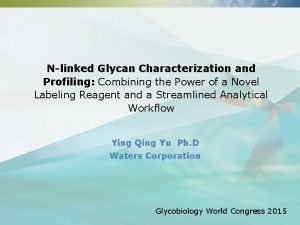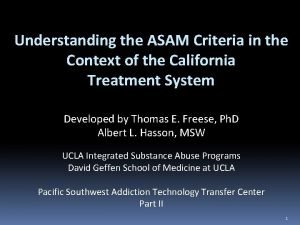Glycan Oxford nomenclature cheat sheet Read the glycan



- Slides: 3

Glycan Oxford nomenclature cheat sheet Read the glycan from backbone to reducing end Fucose (F) Galactose (G) FA 2 G 2 S 1 Glucose Mannose (M) N-acetyl galactosamine (GN) N-acetyl glucosamine aka Glc. NAc (A) Sialic acid (S) Note: 1 core fucose 2 galactose 1 sialic acid 2 antenna starting with Glc. NAc This is the “trimannosyl core. ” It is assumed, not denoted, as it is common to all N-glycans 1

Structures and masses by Glyco Workbench. Oxford nomenclature used to denote glycans. FA 2 G 1 FA 2 G 2 FA 2 G 1 S 1 FA 2 G 2 S 1 I am monitoring these 13 glycans. Here they are shown on Ig. G 1: EEQYNSTYR. These are 13 precursor masses I monitor. They can also be on Ig. G 2, 3, and 4. Ig. G 2/3 can share a sequence: EEQFNSTFR. Some Ig. G 3 also has a sequence of EEQYNSTFR. Ig. G 4 has a sequence of EEQFNSTYR, which has the same mass as some Ig. G 3. To answer my particular questions, I don’t care or need to do the fragmentation to distinguish these, so I monitor 3 “buckets”: Ig. G 1, Ig. G 2/3, Ig. G 3/4. For my current experiment’s samples, I know Ig. G 4 is very low, and so is the Ig. G 4 -like type of Ig. G 3, so I really just monitor Ig. G 1 and Ig. G 2/3. Using the special ions approach, I only need to create 4 special ions, because no matter what the glycan is, they all contain the Y 1, and the fucosylated ones all contain the Y 1+F as well as the Y 1. So the 4 special ions are: -Y 1 and the Y 1+F for Ig. G 1 peptide backbone -Y 1 and the Y 1+F for Ig. G 2/3 peptide backbone Y 1 for Ig. G 1 m/z = 1392, +1 FA 2 Bi (as in bisecting) FA 2 Bi. G 1 FA 2 Bi. G 2 Y 1+F for Ig. G 1 m/z = 1538, +1 Y 1 for Ig. G 2/3 m/z = 1360, +1 Y 1+F for Ig. G 2/3 m/z = 1538, +1

Skyline document—showing only FA 2, FA 2 G 1, and FA 2 G 2 for now. FA 2 can be on Ig. G 1: EEQYNSTYR (to generate the Y 1 and the Y 1+F specific to Ig. G 1) FA 2 can be on Ig. G 2/3: EEQFNSTFR (to generate the Y 1 and the Y 1+F specific to Ig. G 2/3). Those same special ions are detected when different glycans (like FA 2 G 1 or FA 2 G 2) are present on the peptides, because the Y 1 and Y 1+F ions are the same no matter what the glycan is. Only the peptide backbone would change the mass, and I’m only monitoring 2 different peptide backbones.





